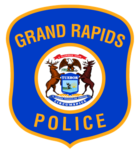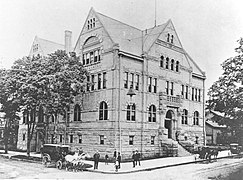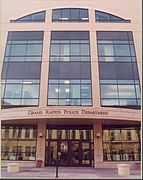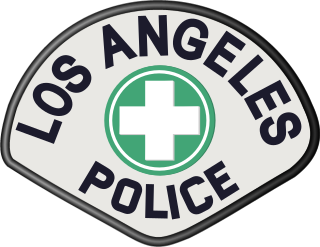
The Los Angeles Police Department (LAPD), officially known as the City of Los Angeles Police Department, is the primary law enforcement agency of Los Angeles, California, United States. With 8,832 officers and 3,000 civilian staff, it is the third-largest municipal police department in the United States, after the New York City Police Department and the Chicago Police Department.

The Sûreté du Québec is the provincial police service for the Canadian province of Quebec. The agency's name is sometimes translated to Quebec Provincial Police (QPP) and Quebec Police Force (QPF) in English-language sources. The headquarters of the Sûreté du Québec are located on Parthenais Street in Montreal's Sainte-Marie neighbourhood, and the service employs over 5,700 officers. The SQ is the second-largest provincial police service and the third-largest police service in Canada.
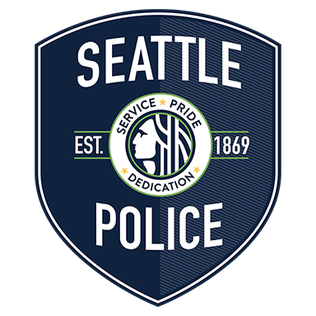
The Seattle Police Department (SPD) is the principal law enforcement agency of the city of Seattle, Washington, United States, except for the campus of the University of Washington, which is under the responsibility of its own police department.

The BART Police (BARTPD), officially the Bay Area Rapid Transit Police Department, is the transit police agency of the BART rail system in the U.S. state of California. The department has approximately three hundred police personnel, including over two hundred sworn peace officers. The chief, Kevin Franklin commands the agency's law enforcement, parking, and community relations services. BART Police participates in a mutual aid agreement with other Bay Area law enforcement agencies. In 2011 and 2012 the department came under national scrutiny due to several officers involved in fatalities of the rail system's patrons.

The Boston Police Department (BPD), dating back to 1838, holds the primary responsibility for law enforcement and investigation within the city of Boston, Massachusetts. It is the oldest municipal police department in the United States. The BPD is also the 20th largest law enforcement agency in the country.

The Metropolitan Police Department of the District of Columbia (MPDC), more commonly known locally as the Metropolitan Police Department (MPD), and, colloquially, DC Police, is the primary law enforcement agency for the District of Columbia, in the United States. With approximately 3,400 officers and 600 civilian staff, it is the sixth-largest municipal police department in the United States. The department serves an area of 68 square miles (180 km2) and a population of over 700,000 people. Established on August 6, 1861, the MPD is one of the oldest police departments in the United States. The MPD headquarters is at the Henry J. Daly Building, located on Indiana Avenue in Judiciary Square across the street from the District of Columbia Court of Appeals and the Superior Court of the District of Columbia. The department's mission is to "safeguard the District of Columbia and protect its residents and visitors with the highest regard for the sanctity of human life". The MPD's regulations are compiled in title 5, chapter 1 of the District of Columbia Code.

The Philadelphia Police Department is the police agency responsible for law enforcement and investigations within the County and City of Philadelphia, Pennsylvania. The PPD is one of the oldest municipal police agencies, fourth-largest police force and sixth-largest non-federal law enforcement agency in the United States. Since records were first kept in 1828, at least 289 PPD officers have died in the line of duty.

The Service de police de la Ville de Montréal is the municipal police agency for the city of Montreal, Quebec, Canada, and the neighbouring communities in the urban agglomeration of Montreal. With over 4,500 officers and more than 1,300 civilian staff, it is the second-largest municipal police agency in Canada after the Toronto Police Service.

The Nebraska State Patrol is Nebraska's only statewide full-service law enforcement agency. Serving Nebraska since 1937, State Patrol troopers perform a wide variety of duties. Those include working with communities to improve public safety, enforcing traffic laws and drug laws, investigating crimes, and enforcing the laws and regulations pertaining to motor carriers.

The Detroit Police Department (DPD) is a municipal police force based in and responsible for the U.S. city of Detroit, Michigan. Founded in 1865, it has nearly 2,500 officers, making it the largest law enforcement organization in Michigan.

The Charlotte-Mecklenburg Police Department (CMPD) is the police department of Mecklenburg County, North Carolina, United States, which includes the City of Charlotte. With 1,817 officers and 525 civilian staff as of 2020, covering an area of 438 square miles (1,130 km2) with a population of 1,000,000+, it is the largest police department between Washington, D.C., and Atlanta, Georgia.

The Rochester Police Department, also known as the RPD, is the principal law enforcement agency of the City of Rochester, New York, reporting to the city mayor. It currently has approximately 852 officers and support staff, a budget of approximately $90 million, and covers an area of 37 square miles (96 km2). The Rochester Police Department has been under a court-ordered federal consent decree from the United States Department of Justice since 1975 over its hiring practices. The decree was part of a 1975 settlement involving racial discrimination.

The Buffalo Police Department (BPD) is the second-largest city police force in the state of New York. In 2012, it had over nine hundred employees, including over seven hundred police officers.

This is a list of protests that took place in Michigan in 2020 following the murder of George Floyd.
Bryan Richard Posthumus is an American politician serving as a member of the Michigan House of Representatives from the 90th district. Elected in 2020, he assumed office on January 1, 2021.

The 1911 Grand Rapids furniture workers' strike was a general strike performed by furniture workers in Grand Rapids, which was then a national leader of furniture production.
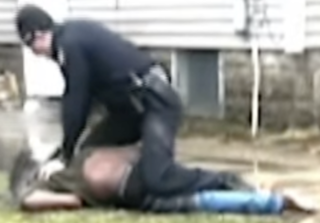
On April 4, 2022, Patrick Lyoya, a 26-year-old resident of Grand Rapids, was fatally shot by Officer Christopher Schurr of the Grand Rapids Police Department during a scuffle between the two in Grand Rapids, Michigan, United States. After Lyoya began to flee the scene, Schurr attempted to detain him, unsuccessfully fired a taser at Lyoya, and then Lyoya attempted to disarm Officer Schurr of the weapon. Ultimately, Lyoya was successful in disarming Officer Schurr. Officer Schurr then discharged one round from his firearm.
